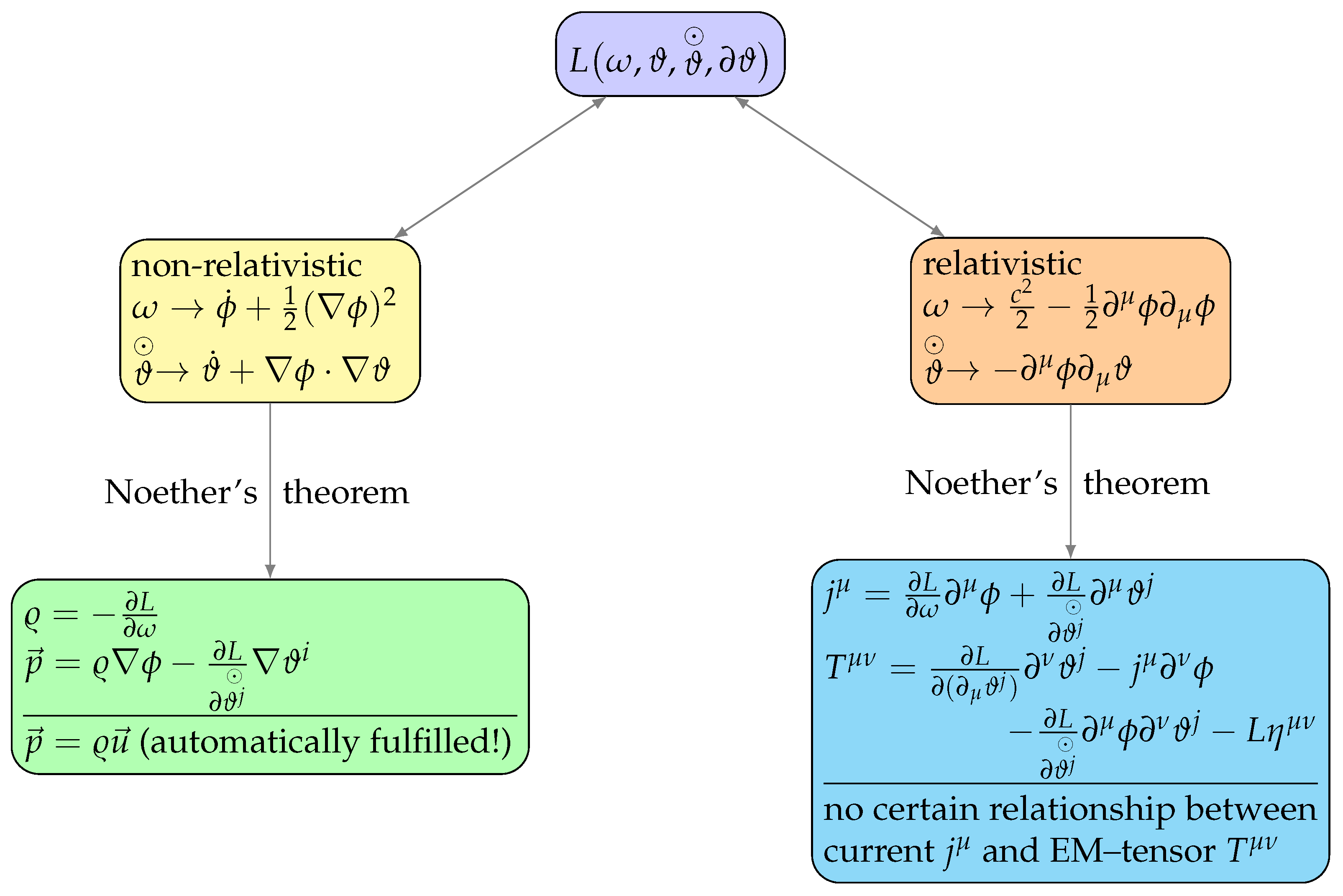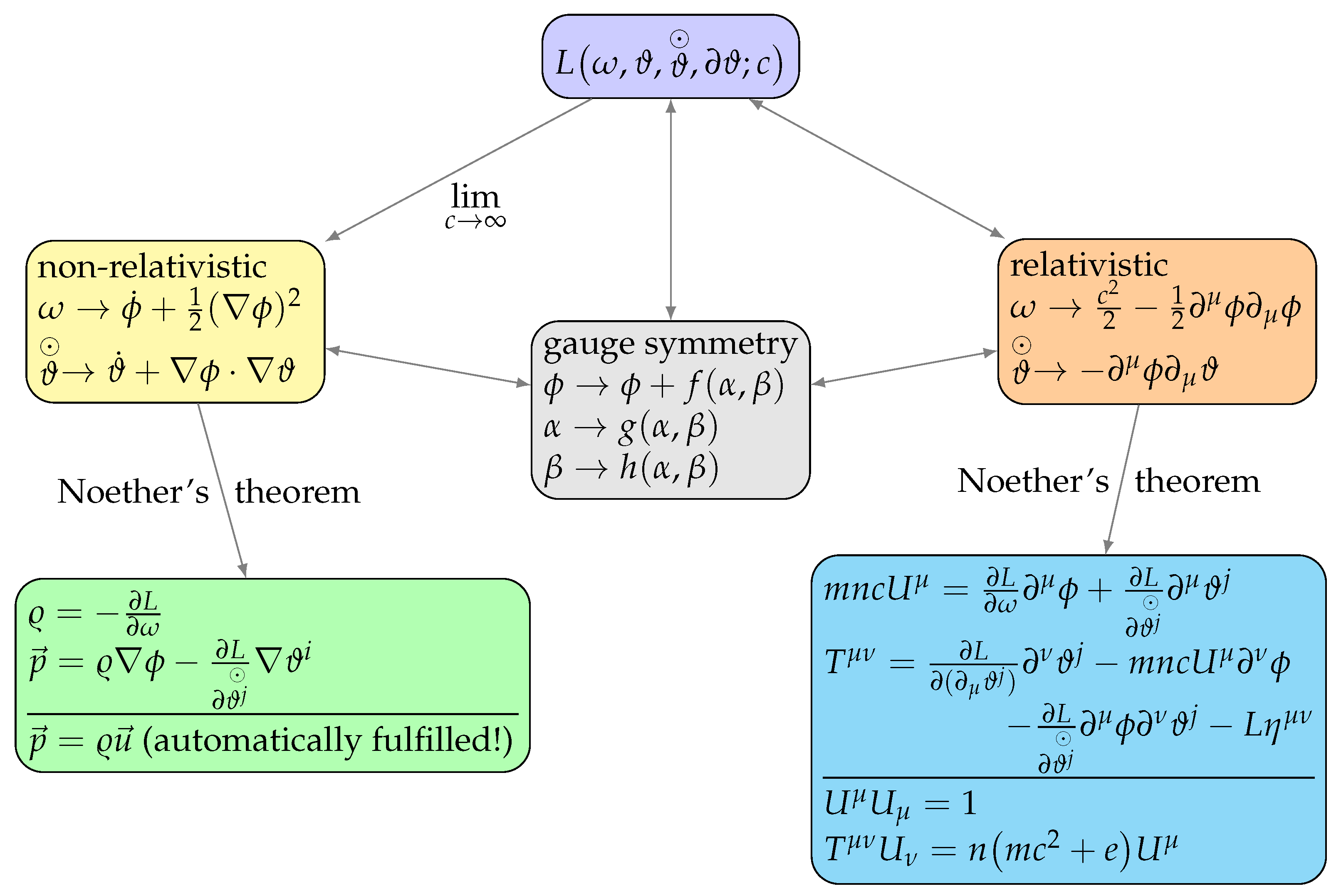Non-Relativistic and Relativistic Lagrangian Pairing in Fluid Mechanics Inspired by Quantum Theory
Abstract
1. Introduction
2. A Short Review of Associated Pairs in Quantum Theory
2.1. General Scheme for Lagrangians Based on Galilean Invariance
2.2. Modified Scheme for Relativistic Lagrangians
2.3. Application to Schrödinger and KG Theory
3. Methodical Approach for Fluid Mechanics
3.1. Motivation
3.2. The Canonical Velocity and Normalisation
4. Results
4.1. A Potential Flow Lagrangian
4.2. Barotropic Inviscid Flow in Clebsch Variables
4.2.1. Initial Assumptions and Integration
4.2.2. Gauge Condition
4.2.3. Eigenvalue Relationship and Solution
4.3. A Lagrangian for Thermo-Fluid Dynamics
4.4. Non-Relativistic Limit
5. Discussion
6. Conclusions
Author Contributions
Funding
Data Availability Statement
Acknowledgments
Conflicts of Interest
Appendix A. Mathematical Elaborations
Appendix A.1. To the Construction of the Lagrangian for Thermo-Fluid Dynamics
Appendix A.2. Eigenvalue in Dissipative Case
Abbreviations
| EM | Energy–momentum |
| KG | Klein–Gordon |
| LF | Lagrange formalism |
| PDE | Partial differential equation |
| MHD | Magnetohydrodynamics |
| QCD | Quantum chromodynamics |
| QFT | Quantum field theory |
References
- Goldstein, H.; Pool, C.; Safko, J. Classical Mechanics, 3rd ed.; Addison Wesley: Reading, MA, USA, 2001. [Google Scholar]
- Greiner, W.; Reinhardt, J. Theoretische Physik, Band 7A, Feldquantisierung; Verlag Harri Deutsch: Frankfurt am Main, Germany, 1993; p. 145. [Google Scholar]
- Anthony, K.H. Hamilton’s action principle and thermodynamics of irreversible processes—A unifying procedure for reversible and irreversible processes. J. Non-Newt. Fluid Mech. 2001, 96, 291–339. [Google Scholar] [CrossRef]
- Seliger, R.L.; Whitham, G.B. Variational principles in continuum mechanics. Proc. R. Soc. London. Ser. A Math. Phys. Sci. 1968, 305, 1–25. [Google Scholar]
- Lin, C.C. International School of Physics Enrico Fermi (XXI). In International School of Physics Enrico Fermi, Course XXI; Careri, G., Ed.; Academic Press: New York, NY, USA, 1963; p. 93. [Google Scholar]
- Bateman, H. On Dissipative Systems and Related Variational Principles. Phys. Rev. 1931, 38, 815–819. [Google Scholar] [CrossRef]
- Clebsch, A. Ueber die Integration der hydrodynamischen Gleichungen. J. F. D. Reine U. Angew. Math. 1859, 56, 1–10. [Google Scholar]
- Panton, R.L. Incompressible Flow; John Wiley & Sons, Inc.: Hoboken, NJ, USA, 1996. [Google Scholar]
- Lamb, H. Hydrodynamics; Cambridge University Press: Cambridge, UK, 1974. [Google Scholar]
- Scholle, M. Construction of Lagrangians in continuum theories. Proc. R. Soc. Lond. A 2004, 460, 3241–3260. [Google Scholar] [CrossRef]
- Scholle, M.; Marner, F.; Gaskell, P.H. Potential Fields in Fluid Mechanics: A Review of Two Classical Approaches and Related Recent Advances. Water 2020, 12, 1241. [Google Scholar] [CrossRef]
- Lin, C.C. Hydrodynamics of Helium II; Technical report; Massachusetts Institute of Technology: Cambridge, MA, USA, 1961. [Google Scholar]
- Schutz, B.F., Jr. Hamiltonian theory of a relativistic perfect fluid. Phys. Rev. D 1971, 4, 3559. [Google Scholar] [CrossRef]
- Scholle, M.; Marner, F. A generalized Clebsch transformation leading to a first integral of Navier-Stokes equations. Phys. Lett. A 2016, 380, 3258–3261. [Google Scholar] [CrossRef]
- Cartes, C.; Descalzi, O. Eulerian-Lagrangian formulation for compressible Navier-Stokes equations. Hydrodynamics—Optimizing Methods and Tools; IntechOpen: Rijeka, Republika Hrvatska, 2011; pp. 109–128. [Google Scholar]
- Wagner, H.J. On the use of Clebsch potentials in the Lagrangian formulation of classical electrodynamics. Phys. Lett. A 2002, 292, 246–250. [Google Scholar] [CrossRef]
- Calkin, M.G. An action principle for magnetohydrodynamics. Can. J. Phys. 1963, 41, 2241–2251. [Google Scholar] [CrossRef]
- Schoenberg, M. Vortex motions of the Madelung fluid. Il Nuovo Cimento (1955–1965) 1955, 1, 543–580. [Google Scholar] [CrossRef]
- Scholle, M.; Mellmann, M. A Relationship between the Schrödinger and Klein-Gordon Theories and Continuity Conditions for Scattering Problems. Symmetry 2023, 15, 1667. [Google Scholar] [CrossRef]
- Khesali, A.R.; Salahshoor, K. Structure of relativistic accretion disk with non-standard model. Astrophys. Space Sci. 2016, 361, 243. [Google Scholar] [CrossRef]
- Chattopadhyay, I.; Kumar, R. Estimation of mass outflow rates from viscous relativistic accretion discs around black holes. Mon. Not. R. Astron. Soc. 2016, 459, 3792. [Google Scholar] [CrossRef]
- Eling, C.; Fouxon, I.; Oz, Y. The incompressible Navier–Stokes equations from black hole membrane dynamics. Phys. Lett. B 2009, 680, 496–499. [Google Scholar] [CrossRef]
- Das, S. Behaviour of dissipative accretion flows around black holes. Mon. Not. R. Astron. Soc. 2007, 376, 1659–1670. [Google Scholar] [CrossRef]
- Davydov, A.; Haar, D. Quantum Mechanics; International series in natural philosophy; Elsevier Science & Technology Books: Amsterdam, The Netherlands, 1976. [Google Scholar]
- Madelung, E. Quantentheorie in hydrodynamischer Form. Z. Für Phys. 1927, 40, 322–326. [Google Scholar] [CrossRef]
- Greiner, W.; Bromley, D. Relativistic Quantum Mechanics. Wave Equations; Springer: Berlin/Heidelberg, Germany, 2000. [Google Scholar]
- van Dantzig, D. On the phenomenological thermodynamics of moving matter. Physica 1939, 6, 673–704. [Google Scholar] [CrossRef]
- Weinberg, S. Gravitation and Cosmology: Principles and Applications of the General Theory of Relativity; Wiley: Hoboken, NJ, USA, 1972. [Google Scholar]
- Padmanabhan, T. Gravitation: Foundations and Frontiers; Cambridge University Press: Cambridge, UK, 2010. [Google Scholar]
- Minazzoli, O.; Harko, T. New derivation of the Lagrangian of a perfect fluid with a barotropic equation of state. Phys. Rev. D Fields Gravit. Cosmol. 2012, 86, 087502. [Google Scholar] [CrossRef]
- Mendoza, S.; Silva, S. The matter Lagrangian of an ideal fluid. Int. J. Geom. Methods Mod. Phys. 2021, 18, 2150059. [Google Scholar] [CrossRef]
- Brown, J.D. Action functionals for relativistic perfect fluids. Class. Quantum Gravity 1993, 10, 1579. [Google Scholar] [CrossRef]
- Taub, A.H. General relativistic variational principle for perfect fluids. Phys. Rev. 1954, 94, 1468. [Google Scholar] [CrossRef]
- Ray, J.R. Lagrangian density for perfect fluids in general relativity. J. Math. Phys. 1972, 13, 1451–1453. [Google Scholar] [CrossRef]
- Hall, G.; Negm, D. Physical structure of the energy-momentum tensor in general relativity. Int. J. Theor. Phys. 1986, 25, 405–423. [Google Scholar] [CrossRef]
- Oliinychenko, D.; Petersen, H. Deviations of the energy-momentum tensor from equilibrium in the initial state for hydrodynamics from transport approaches. Phys. Rev. C 2016, 93, 034905. [Google Scholar] [CrossRef]
- Bakas, I. Energy-momentum/Cotton tensor duality for AdS4 black holes. J. High Energy Phys. 2009, 2009, 003. [Google Scholar] [CrossRef][Green Version]
- Noether, E. Invariante Variationsprobleme. Nachr. d. König. Gesellsch. d. Wiss. zu Göttingen, Math-phys. Klasse, 235–257. English translation by Tavel MA (1971). Transp. Theory Stat. Phys. 1918, 1, 183–207. [Google Scholar]
- Schutz, B.F.; Sorkin, R. Variational aspects of relativistic field theories, with application to perfect fluids. Ann. Phys. 1977, 107, 1–43. [Google Scholar] [CrossRef]
- Webb, G.; Anco, S. Vorticity and symplecticity in multi-symplectic, Lagrangian gas dynamics. J. Phys. A Math. Theor. 2016, 49, 075501. [Google Scholar] [CrossRef]
- Scholle, M.; Marner, F. A non-conventional discontinuous Lagrangian for viscous flow. R. Soc. Open Sci. 2017, 4. [Google Scholar] [CrossRef]
- Schönberg, M. A non-linear generalization of the Schrödinger and Dirac equations (II). Nuovo Cimento 1954, 12, 649–667. [Google Scholar] [CrossRef]
- Schmid, L. Effects of Heat Exchange on Relativistic Fluid Flow; Technical report; NASA TM X-63499; Goddard Space Flight Center: Greenbelt, MD, USA, 1969. [Google Scholar]
- Prigogine, I.; Henin, F.; George, C. Entropy and quasiparticle description of anharmonic lattices. Physica 1966, 32, 1873–1900. [Google Scholar] [CrossRef]
- Salamon, P.; Nitzan, A.; Andresen, B.; Berry, R.S. Minimum entropy production and the optimization of heat engines. Phys. Rev. A 1980, 21, 2115. [Google Scholar] [CrossRef]
- Rebhan, E. Maximum entropy production far from equilibrium: The example of strong shock waves. Phys. Rev. A 1990, 42, 781. [Google Scholar] [CrossRef]
- Yang, C.T. Variational theories in hydrodynamics and hydraulics. J. Hydraul. Eng. 1994, 120, 737–756. [Google Scholar] [CrossRef]
- Rasband, S.; Mason, G.; Matheson, P. Generalized entropy formulation of dissipative magnetohydrodynamics. Phys. Rev. A 1988, 38, 5294. [Google Scholar] [CrossRef]
- Scholle, M.; Ismail-Sutton, S.; Gaskell, P.H. A novel variational perturbation approach for formulating both linear and nonlinear acoustic model equations. Mech. Res. Commun. 2023, 133, 104198. [Google Scholar] [CrossRef]
- Scholle, M.; Anthony, K.H. Line–shaped objects and their balances related to gauge symmetries in continuum theories. Proc. R. Soc. Lond. A 2004, 460, 875–896. [Google Scholar] [CrossRef]
- Aref, H. 150 Years of Vortex Dynamics. Theor. Comput. Fluid Dyn. 2010, 24, 1–7. [Google Scholar] [CrossRef]
- McDonald, B.; Witting, J. A conservation law related to Kelvin’s circulation theorem. J. Comput. Phys. 1984, 56, 237–243. [Google Scholar] [CrossRef]
- Yoshida, Z.; Mahajan, S. Duality of the Lagrangian and Eulerian representations of collective motion—A connection built around vorticity. Plasma Phys. Control. Fusion 2011, 54, 014003. [Google Scholar] [CrossRef]
- Duschl, W.J.; Strittmatter, P.A.; Biermann, P.L. A note on hydrodynamic viscosity and selfgravitation in accretion disks. Astron. Astrophys. 2000, 357, 1123–1132. [Google Scholar]
- Maccarone, T.J. Observational Tests of the Picture of Disk Accretion. Space Sci. Rev. 2014, 183, 101–120. [Google Scholar] [CrossRef]
- Fouxon, I.; Oz, Y. Conformal Field Theory as Microscopic Dynamics of Incompressible Euler and Navier-Stokes Equations. Phys. Rev. Lett. 2008, 101, 261602. [Google Scholar] [CrossRef]
- Mellmann, M.; Scholle, M. Symmetries and Related Physical Balances for Discontinuous Flow Phenomena within the Framework of Lagrange Formalism. Symmetry 2021, 13, 1662. [Google Scholar] [CrossRef]
- Tanehashi, K.; Yoshida, Z. Gauge symmetries and Noether charges in Clebsch-parameterized magnetohydrodynamics. J. Phys. A Math. Theor. 2015, 48, 495501. [Google Scholar] [CrossRef]
- Asanov, G. Clebsch representations and energy-momentum of the classical electromagnetic and gravitational fields. Found. Phys. 1980, 10, 855–863. [Google Scholar] [CrossRef]
- Sato, N. Quantum-fluid correspondence in relativistic fluids with spin: From Madelung form to gravitational coupling. Class. Quantum Gravity 2024, 42, 025017. [Google Scholar] [CrossRef]
- Itô, H. Remarks on Quantum Hydrodynamics. Prog. Theor. Phys. 1955, 13, 543–554. [Google Scholar] [CrossRef]
- Tyabji, S. A quantum theory for non-viscous fluids in the Lagrange variables. In Mathematical Proceedings of the Cambridge Philosophical Society; Cambridge University Press: Cambridge, UK, 1954; Volume 50, pp. 449–453. [Google Scholar]


Disclaimer/Publisher’s Note: The statements, opinions and data contained in all publications are solely those of the individual author(s) and contributor(s) and not of MDPI and/or the editor(s). MDPI and/or the editor(s) disclaim responsibility for any injury to people or property resulting from any ideas, methods, instructions or products referred to in the content. |
© 2025 by the authors. Licensee MDPI, Basel, Switzerland. This article is an open access article distributed under the terms and conditions of the Creative Commons Attribution (CC BY) license (https://creativecommons.org/licenses/by/4.0/).
Share and Cite
Ismail-Sutton, S.; Scholle, M.; Gaskell, P.H. Non-Relativistic and Relativistic Lagrangian Pairing in Fluid Mechanics Inspired by Quantum Theory. Symmetry 2025, 17, 315. https://doi.org/10.3390/sym17030315
Ismail-Sutton S, Scholle M, Gaskell PH. Non-Relativistic and Relativistic Lagrangian Pairing in Fluid Mechanics Inspired by Quantum Theory. Symmetry. 2025; 17(3):315. https://doi.org/10.3390/sym17030315
Chicago/Turabian StyleIsmail-Sutton, Sara, Markus Scholle, and Philip H. Gaskell. 2025. "Non-Relativistic and Relativistic Lagrangian Pairing in Fluid Mechanics Inspired by Quantum Theory" Symmetry 17, no. 3: 315. https://doi.org/10.3390/sym17030315
APA StyleIsmail-Sutton, S., Scholle, M., & Gaskell, P. H. (2025). Non-Relativistic and Relativistic Lagrangian Pairing in Fluid Mechanics Inspired by Quantum Theory. Symmetry, 17(3), 315. https://doi.org/10.3390/sym17030315






